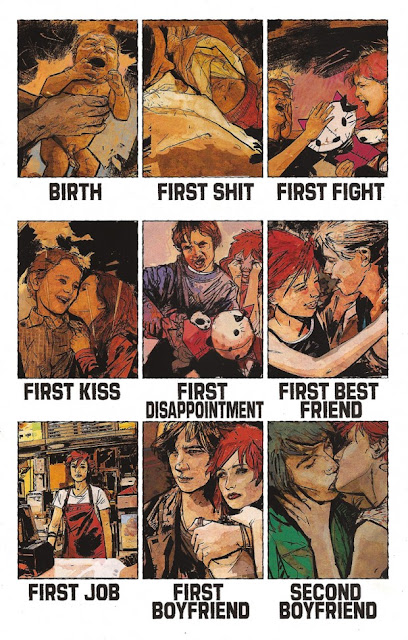“Revolution!!”
“Rage against the machine.”
“The world is broken and no one will fix it.”
These are all quotes from Brian Michael Bendis’ script for the first issue of Scarlet, which is reprinted as a bonus feature at the end of the collection. The Scarlet Book One Hardcover collects the five comics that reunited Bendis with Alex Maleev for their first major project together since Daredevil. It is far from the typical comic book story, and it’s a kind of yarn that has been all too rare for Bendis since he “hit it big time” and became Marvel’s go-to writer.
Scarlet Rue is a woman who has been through a lot. She has been victimized by a corrupt society. Sure, there’s plenty of people who have suffered injustice, but hardly anyone is actually able to turn around and say “I’m not going to take this any longer” like she does. Scarlet is going to have to be extreme, and she needs to get results so that she can prove that the world is a place with really huge problems that people seem not to ever notice.
What makes a modern day revolutionary like Scarlet? She once hung around with people in Portland, Oregon who just might have looked like derelicts. They were truly harmless, and Scarlet was in love with one of them, a punkish-looking guy named Gabriel Ocean. A police officer decides to start some trouble, demanding that they empty their pockets because “they must have drugs on them.” Actually, the cop has quite an addiction himself, so anything he finds will be seized for his own private stash. He’s done this kind of thing before. Scarlet and company really don’t have anything and the whole procedure is inappropriate. Gabriel punches the officer...and then a foot chase follows. The end results: Gabriel is shot and killed (and later an online headline falsely proclaims that one of Portland’s “most dangerous drug dealers” has been brought to justice), and Scarlet gets a bullet to the head that doesn’t kill her. She wakes up in the hospital, changed forever. Someone evil has ruined her life and is time for two things now: revenge first, and revolution second.
Things seem to proceed pretty easily and quickly for Scarlet. She’s making full use of the things that we all use and hear about everyday. A video is posted online of her taking revenge on her boyfriend’s killer, and the following phone conversation between her and the Portland Chief of Police. Enthusiastic supporters participate in a flashmob that gathers hundreds of people in downtown Portland. Scarlet builds herself into a force that cannot be ignored, and Book One promises to show just the beginning of a new kind of revolutionary.
In his introductory notes in his script for Maleev, Bendis remarks that “You’ll also notice that I am using structure and narrative techniques that are anti-cinematic.” This was something that I absolutely loved about Scarlet. It seems like many people tend to think of comics as movies put down on paper. Sure, there is a common visual element, but one has audio and the other has text. And there are plenty of things that can be done in a comic that can’t be accomplished in film.
Take for instance the way that Bendis and Maleev give nice and tidy recaps of what happened in a character’s life that brought them to where they are now. Plenty of details of Scarlet’s life are told in just three pages. A simple small image and a caption inform the reader of anything from “birth” (a screaming baby fresh from the womb) to “first job” (a teenaged Scarlet standing behind the counter at some kind of a fast food joint) to “first true love” (a dreamy picture of Gabriel).
 |
| Scarlet's backstory, told in a way that only comics can. |
I guess that there are some implausible things that are difficult to ignore in Scarlet. I understand that Bendis loves Portland. But I found it kind of hard to believe that she could successfully remain in hiding in a city like that. She’s killed a police detective, she stands out in a crowd, and she never moves from Portland...it shouldn’t be too hard to find her, right? Scarlet makes me feel like the fictional Portland Police Department is pretty much useless, and I can only hope that their real-life counterparts are a little better at their jobs!
Also in the “stretching credibility” department: Scarlet survives being shot in the head. Okay, this is fine, I guess. It spurs her on to become the person she never expected to be. And I guess an officer could mess up on a headshot. But by the book’s end Scarlet has survived yet another thing that really should have killed her. Let’s just say that a grenade is used and she somehow mysteriously escapes unharmed. It just seemed unlikely to me, that’s all.
Put those things aside and just sit back with a refreshing indie-feeling comic that just so happens to be put out by two of comics’ biggest stars. Both writer and artist are clearly challenging themselves in Scarlet and pushing themselves to do things in new and different ways. Now we can only hope that moving on to Scarlet Book Two remains a priority for Bendis and Maleev. We’ll see how that pans out...the team is already hard at work on a new Moon Knight series, and personally, I’d rather see more of Scarlet.





No comments:
Post a Comment